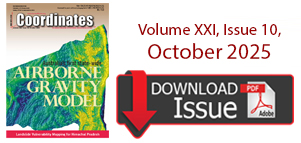| GIS News | |
GIS
Enugu govt partners World Bank on GIS-based road mapping
ENUGU State Government has said it is partnering with World Bank on GISbased road inventories and mapping for easy identification of rural road and economic development. Ifeanyi Ugwuanyi Project co-ordinator of Rural Access and Mobility Project, RAMP, ll, Chief Chinedu Ugwu, who revealed this at a stakeholders’ sensitisation workshop and training on GIS-based road inventories and mapping in Enugu, said it would improve security, infrastructure and agriculture. Ugwu said the GIS system and its mapping would allow the state to have real-time data for proper satellite identification of places and locations within the state. He noted that the project would also help the government to know the situation of all roads, houses, schools, markets, hospitals, bridges, river crossing, farms and other important landmarks of the state. www.vanguardngr.com
BASF Automotive Solutions to develop paints that reflects LiDAR
BASF Automotive Solutions is working on improving lidar detection with nearinfrared reflective dark automotive paint colors so that it’s easy for lidar to detect vehicles and pedestrians.
Dozens of companies, possibly even more, are racing to improve upon existing lidar to solve this problem. Current versions of lidar can have difficulty distinguishing dark-colored cars as Dark colors tend to absorb more of the lidar’s pulses than they reflect, which makes them difficult to see. It’s kind of like wearing a black shirt on a sunny day versus wearing a white shirt. The black shirt absorbs, the white shirt reflects.
BASF is changing the chemistry of its automotive paints so that they are more reflective to lidar. Specifically, the company stated that the color coat doesn’t use any carbon black, which is one of the main culprits in the absorption of lidar waves, and the undercoat is formulated so that it’s highly reflective to lidar. https://automotive.basf.com
The World Bank to support Geospatial Information Management in 30 countries
The World Bank and UN-GGIM collaborated in the development of the Integrated Geospatial Information Framework (IGIF), which was endorsed at the eighth session of the United Nations Committee of Experts on Global Geospatial Information Management (UN-GGIM) from 1 – 3 August 2018 at the United Nations Headquarters in New York. This framework and subsequent implementation guide is designed to help member states to better manage their geospatial information at national or sub-national levels.
As next steps, the World Bank will provide assistance to countries to apply the IGIF at the country and local levels. The first country-level Action Plan has already been prepared for Palestine and, at the subnational level, for Tirana, Albania. The work is underway in other countries such as Vietnam and Guyana. Simultaneously, the World Bank is working with partners to advance plans for more countries.
In this context, the World Bank announced a call for action and an ambitious goal to help at least 30 countries in three years, to cover activities like;
▪ Development of the geodetic reference framework
▪ Financing of Continuously Operating Reference Stations (CORs)
▪ Collection of fundamental data
▪ Establishment of a geoportal
▪ Financing equipment/ computers/systems
▪ Training and capacity building programs
▪ Support in drafting laws and regulations in this area
The process of requesting World Bank support for investment in geospatial information involves the responsible agency for a geospatial information infrastructure to send a request to the World Bank through their Ministry of Finance. Once the request has been formally received and accepted, the Bank mobilizes a team of experts to work with governments to prepare the Action and Investment plan and detailed project.
ICTA launches NSDI in Sri Lanka
The National Spatial Data Infrastructure (NSDI), a highly awaited platform for geo spatial information in Sri Lanka, was ceremonially launched by the Information & Communication Technology Agency of Sri Lanka (ICTA) recently at Trace Expert City.
Former Telecommunication, Digital Infrastructure and Foreign Employment Ministry Secretary Wasantha Deshapriya, the pioneer in initiating NSDI in Sri Lanka, graced the occasion as the Chief Guest. Other distinguished invitees, including senior Government officials, industry leaders, academia, NGOs, INGOs, and media also dignified this launching ceremony.
The NSDI is a platform consisting of a website, a metadata catalogue and a geoportal which facilitate accessing geospatial information for decision makers. While the website provides the introduction to the NSDI and its services and governance structure, the metadata catalogue provides the background details about the geospatial data. The available geospatial data, which were scattered across many organisations, can be accessed through this geo-portal in a single window.
Addressing the audience, Chief Guest Wasantha Deshapriya congratulated everyone involved in bringing NSDI to the current state and launch. “Being a publicfunded platform, NSDI could be used to provide marvellous benefits to citizens of the country through sharing data and information among organisations.”
The development of the Sri Lanka NSDI is a collaborative effort of many Government organisations, including the Survey Department of Sri Lanka, Disaster Management Centre, Department of Agriculture, Department of Wildlife, Department of Forest, Coast Conservation Department, Department of Census and Statistics, etc., facilitated by ICTA. NSDI can be accessed via https://nsdi.gov.lk.












 (No Ratings Yet)
(No Ratings Yet)






Leave your response!